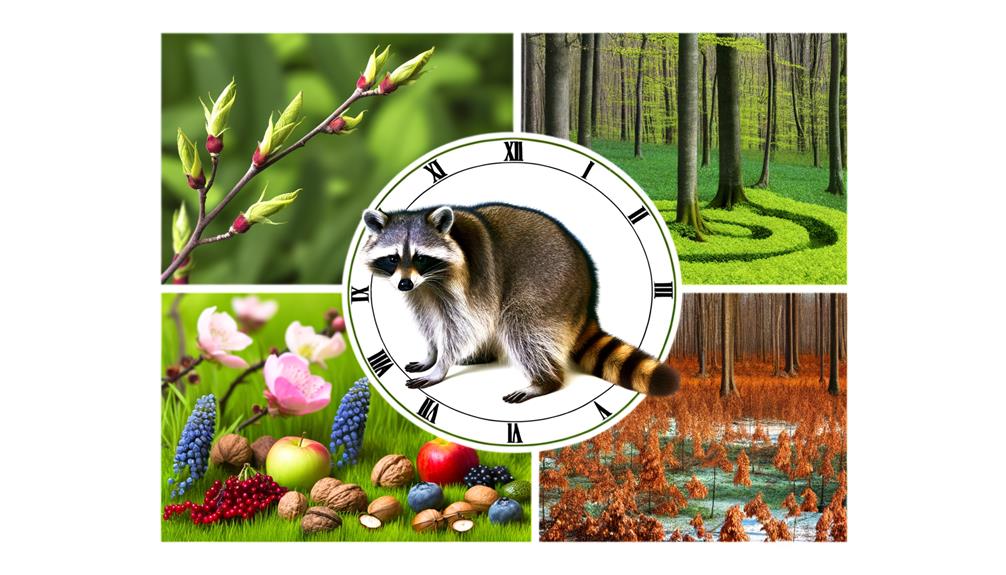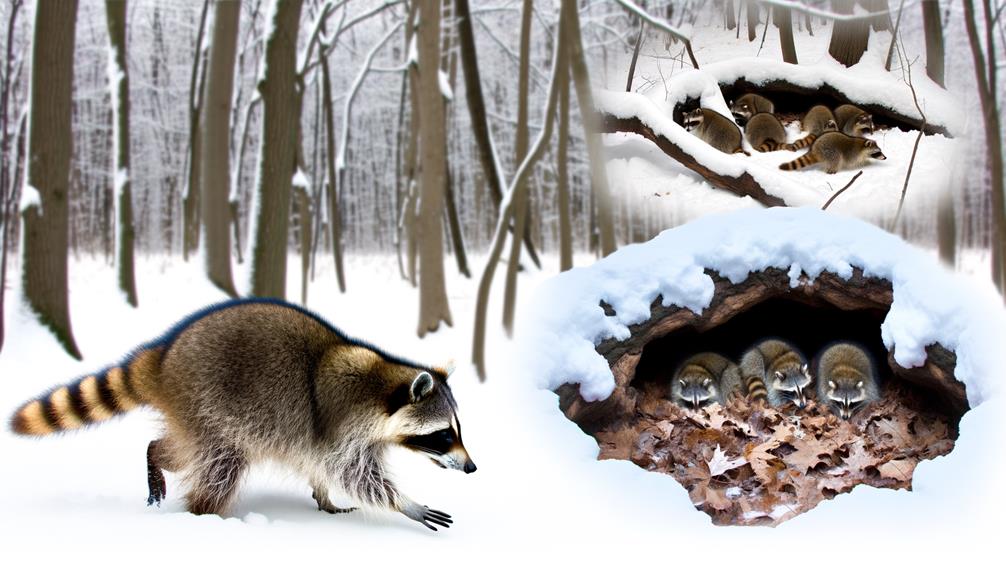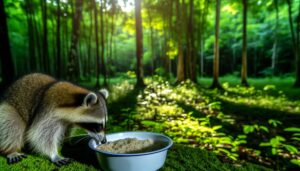Understanding Raccoon Fasting: How Long Can They Go Without Eating?
Raccoons can endure without food for several weeks, thanks to their efficient fat storage and metabolic flexibility. They can increase their body fat by up to 50% before winter, which provides essential caloric reserves.
In periods of food scarcity, raccoons reduce their metabolic rate, activity levels, body temperature, and energy expenditure. Such adaptations minimize physiological stress and extend survival.
However, prolonged lack of food leads to significant health impacts, including weight loss, muscle atrophy, and increased susceptibility to infections. For a thorough understanding of raccoon survival mechanisms, their dietary habits and seasonal behaviors merit closer scrutiny.

Key Takeaways
- Raccoons can survive several weeks without food by utilizing stored body fat.
- They have efficient fat storage mechanisms, increasing body fat by up to 50% before winter.
- Metabolic rates decrease during prolonged fasting to conserve energy.
- Prolonged fasting leads to physiological stress and increased vulnerability to infections.
- Extended starvation can result in organ failure and death in raccoons.
Raccoon Metabolism

Understanding raccoon metabolism is essential to determining how long these animals can survive without food. Their metabolic rate greatly influences their energy expenditure and nutritional needs. Raccoons (Procyon lotor) exhibit a basal metabolic rate (BMR) that is relatively high compared to other mammals of similar size. This elevated BMR necessitates a consistent intake of calories to maintain homeostasis and support daily activities.
Additionally, raccoons exhibit metabolic flexibility, allowing them to adjust their energy expenditure based on seasonal variations and food availability. During periods of scarcity, raccoons can enter a state of torpor, reducing their metabolic rate to conserve energy. However, prolonged fasting can lead to significant physiological stress, underscoring the importance of regular nutrient intake for their survival.
Typical Diet
To support their elevated basal metabolic rate and metabolic flexibility, raccoons consume a diverse diet that adapts to seasonal availability and ecological conditions. Primarily omnivorous, their diet includes fruits, nuts, insects, small mammals, and aquatic organisms.
Studies indicate a marked preference for high-energy foods such as acorns and berries during autumn, aiding in fat accumulation for winter survival. In urban environments, raccoons exploit anthropogenic food sources, including household waste and pet food. This dietary adaptability facilitates their survival in varied habitats, from forests to cityscapes.
Additionally, their opportunistic feeding behavior and dexterous forepaws enable them to access a broad range of food items, underscoring their ecological versatility and resilience.
Survival Without Food

Raccoons exhibit remarkable resilience when faced with food scarcity, leveraging their fat reserves and physiological adaptations to endure extended periods without sustenance. Studies suggest that raccoons can survive without food for up to several weeks, depending on their initial health and environmental conditions.
During times of food shortage, raccoons utilize their stored body fat as an energy source, which is essential for maintaining crucial bodily functions. Additionally, their nocturnal and opportunistic feeding behaviors enhance their ability to locate sporadic food sources, further extending their survival capabilities.
The ability to survive without immediate access to food highlights the species' adaptability and robustness in fluctuating environments, ensuring their continued survival in diverse habitats.
Physiological Adaptations
Raccoons exhibit remarkable physiological adaptations that enhance their survival during periods of food scarcity. These adaptations include metabolic rate adjustments that allow them to conserve energy.
Efficient fat storage mechanisms provide essential caloric reserves. Understanding these adaptive traits offers critical insights into how raccoons can endure extended intervals without sustenance.
Metabolic Rate Adjustments
One of the key physiological adaptations that enable raccoons to endure prolonged periods without food is their ability to reduce their metabolic rate. This adjustment is vital for conserving energy during food scarcity. By lowering their metabolic rate, raccoons can decrease their overall energy expenditure, thereby extending their survival time without nourishment. Research indicates that raccoons can significantly slow their metabolism, which directly correlates with reduced caloric requirements.
| Aspect of Metabolism | Change During Food Scarcity |
|---|---|
| Basal Metabolic Rate | Decreases |
| Activity Level | Reduces |
| Body Temperature | Lowers |
| Energy Expenditure | Minimizes |
| Heart Rate | Slows |
These metabolic adjustments are essential for raccoons to maintain essential physiological functions while minimizing energy use.
Fat Storage Mechanisms
In addition to metabolic rate adjustments, the ability to store fat is another critical physiological adaptation that enables raccoons to survive extended periods without food. This adaptation is particularly useful during winter months when food sources are scarce.
Raccoons accumulate fat reserves during times of abundance, which they later metabolize to sustain their energy requirements. Research has shown that raccoons can increase their body fat by up to 50% before winter.
- Seasonal fat accumulation: Essential for surviving food shortages.
- Energy density: Fat provides more than twice the energy per gram compared to carbohydrates and proteins.
- Hormonal regulation: Leptin and insulin play roles in fat storage and metabolism.
- Adaptive thermogenesis: Helps in maintaining body temperature by utilizing fat reserves efficiently.
This fat storage mechanism is pivotal for raccoon survival.
Seasonal Behavior

Raccoons exhibit marked seasonal behaviors, particularly in winter when dormancy patterns become pronounced. Food availability fluctuations during colder months necessitate adaptive survival strategies, such as increased fat storage and reduced metabolic rates.
These behavioral adaptations are critical for sustaining raccoons during periods when food resources are scarce.
Winter Dormancy Patterns
During the winter months, raccoons enter a state of torpor, reducing their metabolic rate to conserve energy when food resources are scarce. This adaptive strategy allows them to survive for extended periods with minimal food intake.
Torpor in raccoons is characterized by several physiological changes:
- Metabolic Suppression: Raccoons lower their metabolic rate to decrease energy expenditure.
- Body Temperature Regulation: Their body temperature drops slightly, further conserving energy.
- Reduced Activity: Physical activity is minimized, helping them to preserve stored energy.
- Fat Reserves Utilization: They rely primarily on fat reserves accumulated during the warmer months.
This state of torpor is not true hibernation but serves as an effective means of energy conservation during harsh winter conditions.
Food Availability Fluctuations
Amidst the changing seasons, the availability of food resources plays a pivotal role in shaping raccoon behavior and survival strategies. During spring and summer, raccoons benefit from abundant resources, including fruits, insects, and small vertebrates, which allow them to build fat reserves.
Conversely, autumn heralds a period of intensive foraging as they prepare for the lean winter months. Studies indicate that food scarcity during winter forces raccoons to enter a state of torpor, reducing their metabolic rate to conserve energy.
This seasonal fluctuation in food availability demands that raccoons optimize their foraging behavior and energy expenditure, ensuring they can endure periods of limited resources while maintaining physiological functions essential for survival.
Survival Strategies Adaptation
Adapting to the seasonal ebb and flow of environmental conditions, raccoons employ a range of survival strategies that include behavioral and physiological modifications to optimize energy use and resource acquisition. These strategies are critical for overcoming periods of food scarcity and adverse weather conditions.
Notable adaptations include:
- Hibernation-like states: Raccoons enter a state of torpor during extreme cold, reducing metabolic rates to conserve energy.
- Fat accumulation: Prior to winter, raccoons increase food intake to build fat reserves, which serve as energy stores.
- Foraging flexibility: They exhibit opportunistic feeding, exploiting a diverse diet ranging from fruits to small vertebrates.
- Shelter utilization: Raccoons use dens in tree cavities and burrows to protect against harsh environmental conditions.
These adaptive strategies are essential for their survival during seasonal changes.
Impacts of Starvation
Starvation in raccoons leads to a cascade of physiological and behavioral changes, greatly impacting their overall health and survival. Prolonged periods without food result in significant weight loss, muscle atrophy, and depletion of fat reserves. Metabolic rates decline as the body attempts to conserve energy, often causing hypoglycemia and hypothermia.
Behavioral adaptations include increased foraging efforts and altered activity patterns, potentially increasing exposure to predators and environmental hazards. Immunocompetence is compromised, making raccoons more susceptible to infections and diseases. Additionally, reproductive functions are impaired as energy resources are redirected from non-essential activities.
Studies have documented that extended starvation periods can result in organ failure and, ultimately, death, underscoring the critical importance of regular nutrient intake for raccoon survival.
Conclusion
The resilience of raccoons in the face of food scarcity is underpinned by their adaptable metabolism, diverse diet, and physiological adaptations.
Seasonal behaviors further facilitate their survival during periods of nutritional deficit.
However, prolonged deprivation can inevitably lead to critical impacts on their well-being.
Understanding these factors illuminates the intricate balance raccoons maintain with their environment and underscores the profound consequences of starvation, thereby highlighting the importance of ecological stability for their sustenance.






